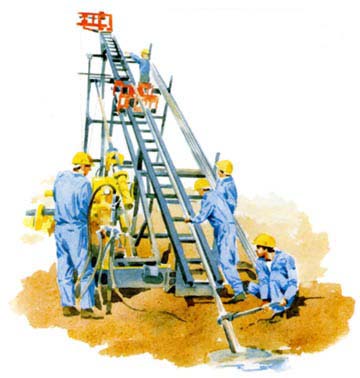DIRECTIONAL DRILLING, STEERING AND POSITIONING
In the last 10 years this new technology has increased rapidly covering numerous applications from mine exploration to utilities and infrastructure projects; gas pipelines, water & sewage, power and telecom, as well as geological preinvestigations and shallow oil exploration.

Figure 1: Small directional drill rigs for hole length up to 800 meters
and diameters up to 102 mm. With backreamers the hole can
be reamed up
to 300 - 500 mm.
The cooperation between SRG (Scandianvian Rock Group) and Devico in highly accurate directional drilling is based on Devico's unique new technology called the DeviDrill system. The system consists of the Devidrill which drill and steers the hole in a predefined curve from 0 to 8 degrees/ 10 meter. The DeviTool is the positioning system that measures dip angle, azimut direction and the toolface orientation. Logged into the software DeviSoft, this gives an accurate position and path of the drill hole. With this tool, the rigoperator is able to steer the hole with a very high accuracy on to the target. From Devico's reference projects the accuracy for holes up to 400 meters is about 0.1% of drilled distance in the vertical plane, and 0.3% in the horizontal plane. (The Devidrill with it's typical "pads" can be seen in the picture at the top of this page).
.
Horizontal Directional Drilling
Horizontal directional drilling (hdd) is mainly used for installation of utilities and pipes in
soil
and
soft ground close to the surface. The words "trenchless" and "no-dig" are also common to describe
this technology.
Tunnel & GeoConsult's contact in Seattle, USA is the company Geological Boring engaged in
production of drilling tools for the HDD industry.
. . .
Figure 2: Illustration of horizontal directional drilling.
The second
steering system is the 12.5" mini-TBM untill now called the Colibomac (Continious lining boring machine). An automated drilling device that can
drill through both soft and hard rock with a minimum penetration rate of 3-5 meters/hour in granite. The
Colibomac is developed mainly for the oil industry at the Petroleum Research Institute in Trondheim, Norway. The project
has been financed by the Norwegian research Institute and the Norwegian petroleum company Statoil. So far
the Colibomac is only a prototype that has been drilling a test tunnel of 42 meter. 2 wide expandable kewlar pads 2 meters apart allows
the Colibomac to penetrate through wide clay zones and other soft ground material without loosing it's grip.
Lack of finance has so far stranded the project.
Figure 3: Hdd rig working with cable installation in a busy traffic intersection in Seattle. Drilling and istallation work is proceeding under the street without interfering the traffic.
.
.
.
.
.
.
.
.
Senior Engineering Geologist
phone: +47-918 41041
Home
Experience the ultimate in water pipe smoking with our high-quality bongs, designed for an unmatched smoking session. Crafted from durable materials, these water pipes ensure smooth hits and enhance flavor, elevating your enjoyment to new heights. With innovative designs and easy maintenance, our bongs provide a perfect blend of style and functionality, making every session memorable. Indulge in the best with our premium selection today!